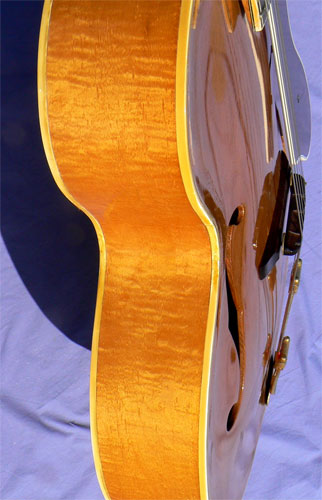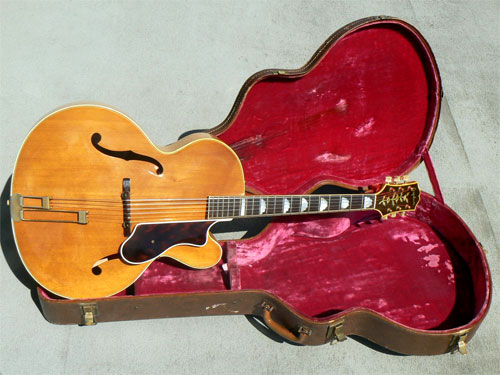Home / Instruments
/Accessories / Ordering / Tips
archtop.com
1951 Epiphone Deluxe Regent, Super Jumbo Body
Status: Pricing and hold status for all instruments currently available
is shown on our Instruments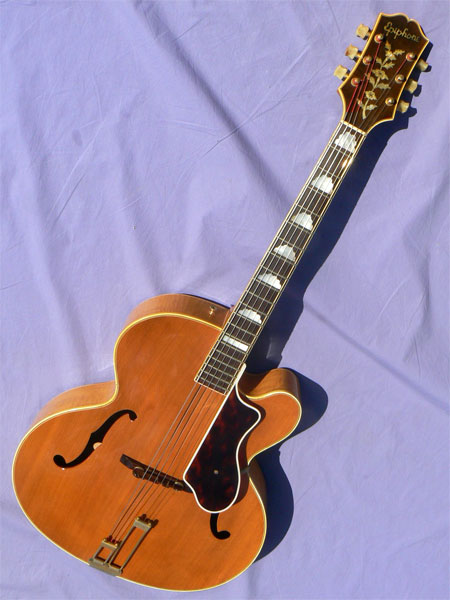 page here. If this instrument
does not appear on the Instruments page
it has been sold, and is no longer available. Photos and descriptions of
Previously Sold instruments may be found here. To be notified of examples of this
model or similar instruments in the future, please contact [email protected],. Please be specific
on which instrument(s) you're looking for, and we'll be happy to contact
you as soon as they become available.
page here. If this instrument
does not appear on the Instruments page
it has been sold, and is no longer available. Photos and descriptions of
Previously Sold instruments may be found here. To be notified of examples of this
model or similar instruments in the future, please contact [email protected],. Please be specific
on which instrument(s) you're looking for, and we'll be happy to contact
you as soon as they become available.
Serial #: 62722
Body size at lower bout: 18 1/2" Scale length: 25
1/2" Nut width: 1 11/16" Neck depth: .94/1.06, 1st/10th frets
Materials: Highly figured solid fiddleback maple back; solid tiger flame maple neck and sides; solid carved quartersawn bookmatched Adirondack spruce top; 3-piece tiger maple neck; 5-ply body binding; triple-bound heel cap, bound neck and head stock; solid Brazilian rosewood fingerboard with mother of pearl cloud inlay; ornate pearl tree-of-life peghead inlay.
Hardware: Original gold hardware includes Pat. Pend. Frequensator tailpiece; epsilon-logo 16X1 tuners; hex-key truss rod. Adjustable compensated Brazilian rosewood bridge. Vintage correct triple-bound leopard tortoise pickguard.
Notes: By 1951, Epiphone, Inc. had hit some challenging times. The postwar boom in acoustic archtops had faded in favor of the popular new electric models like the ES-175. And labor unrest at the New York plant would soon result in its relocation to Philadelphia. In an attempt to broaden their audience, new budget archtops like the Devon and Byron models had been introduced, but neither gained significant traction. And at the top end of the line, the firm made a curious move. Their flagship Deluxe model, which had competed with Gibson's 17" L-5 since 1935, was suddenly upsized to over 18 inches.
Gibson had already begun offering a second 18" archtop for three years, with the debut of the Super 300 in 1948. However, the S-300 was available only with a noncutaway body at that time, and so perhaps Epiphone saw their chance. In Epi's 1950 catalog, the upsized 18" Deluxe was introduced, and listed as available in both cutaway and noncut versions. (The cutaway is not pictured, however, though a few examples, are known to have been built as early as 1949.)
Not only was the massive 18 1/2" lower bout larger than the Gibson Super 400, but the cutaway on the new model was several frets deeper as well, extending the useful range of the fingerboard. (Though bigger in the lower bout than the Super 400, the Deluxe Regent is paradoxically more comfortable to hold, as the upper bout is a full inch smaller than its Gibson counterpart, and the waist is narrower as well.)
How Epiphone planned to differentiate the upsized Deluxe from its super jumbo Emperor is unclear, as the two models were now virtually identical. With only a $50 price difference, Epi's two top models differed only in the most incidental of cosmetics. The Emperor's bound f-holes went unbound on the Deluxe, and the number of plies in the binding was reduced a bit. Indeed, the most significant distinction between the two models was on the fingerboard, where the Deluxe retained its signature cloud pattern inlays.
What we can say for sure is that it appears that a single small batch of 18" Deluxe Regents was produced sometime around the Spring of 1951. Of the six that are listed in the NY Epiphone Database, this guitar is the earliest of the batch, and one of just three pictured in natural finish. Just four serial numbers after the last of this batch was built, the model reverted to its previous size, and the 18" Deluxe became one of the shortest detours in Epiphone history.
The instrument has been maintained in exceptionally fine condition, with all-original gold hardware, and a handsome recent bound tortoise pickguard from an original template. The original blonde finish of the body has ambered to a warm honey color, with just a bit of fine scattered checking visible only at a fairly acute angle. Free of pick, buckle, thumb or fingerboard wear, this magnificent instrument shows few signs of play for its long career. The soundboard is hand graduated of extremely fine grained Adirondack spruce, with a body of highly figured tiger maple, particularly prominent in the gently rounded C-profile neck. The instrument has an open, resonant lower register, with clear, brilliant highs, and exceptional power and projection. With fine high pro fretwork, the guitar has abundant headroom and dynamic range, with smooth low action over a fresh high precision setup.
An instrument of exceptional rarity, performance, and appeal, this historic guitar is a outstanding opportunity for the player and collector alike. One only: call now.
Setup: Trussrod tension and neck relief adjusted; bridge height adjusted; bridge compensation set; string slots at nut and bridge inspected and recut as necessary; bridge foot contour inspected and fit to top as necessary; bridge radius inspected and recurved as necessary; bridge wheels and tuners lubricated; fingerboard and bridge oiled; body and neck cleaned and hand polished. Action is 4/64 to 5/64" at the 12th fret, with medium gauge .013 phosphor bronze strings.
Case: Original Lifton Epiphone deluxe brown arched plush lined hardshell case, with original truss rod wrench.
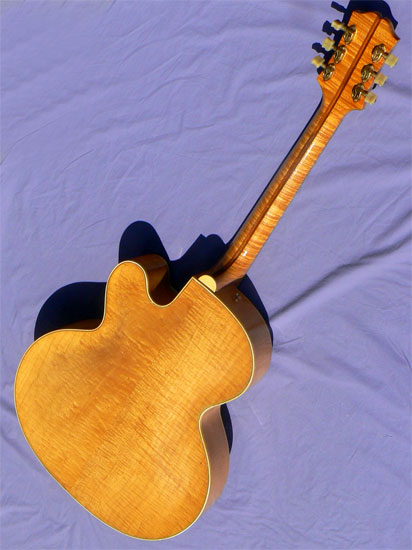
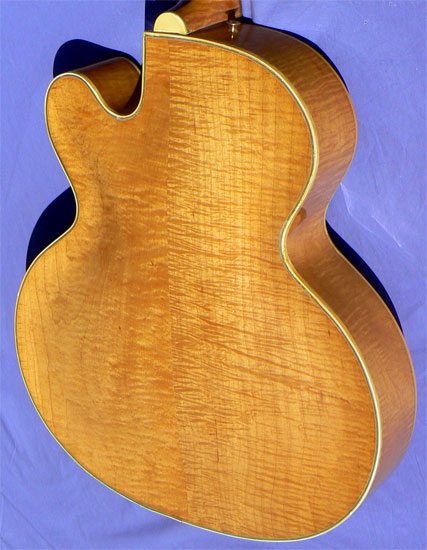
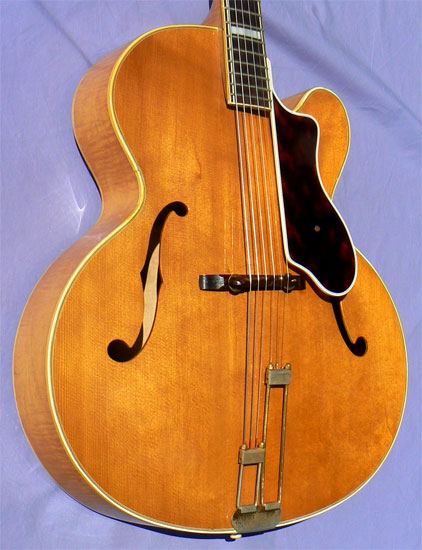
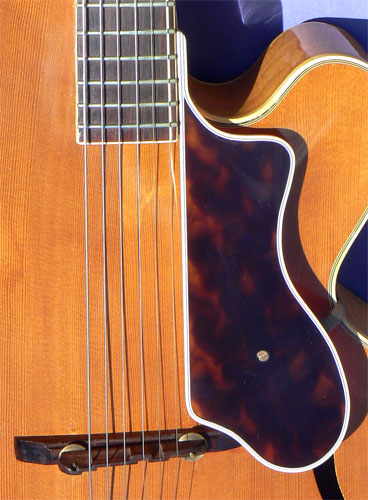
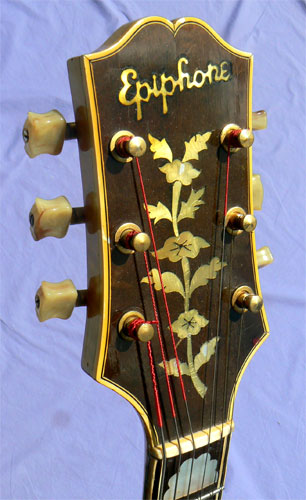
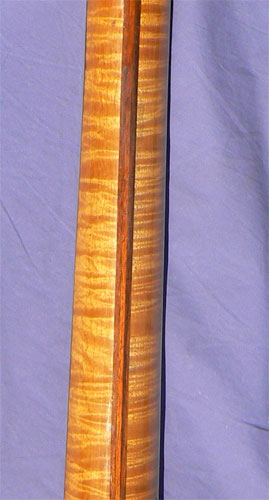
 page here. If this instrument
does not appear on the Instruments page
it has been sold, and is no longer available. Photos and descriptions of
Previously Sold instruments may be found here. To be notified of examples of this
model or similar instruments in the future, please contact [email protected],. Please be specific
on which instrument(s) you're looking for, and we'll be happy to contact
you as soon as they become available.
page here. If this instrument
does not appear on the Instruments page
it has been sold, and is no longer available. Photos and descriptions of
Previously Sold instruments may be found here. To be notified of examples of this
model or similar instruments in the future, please contact [email protected],. Please be specific
on which instrument(s) you're looking for, and we'll be happy to contact
you as soon as they become available.






